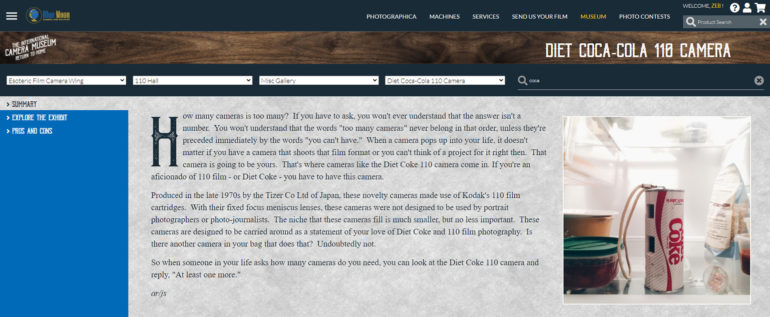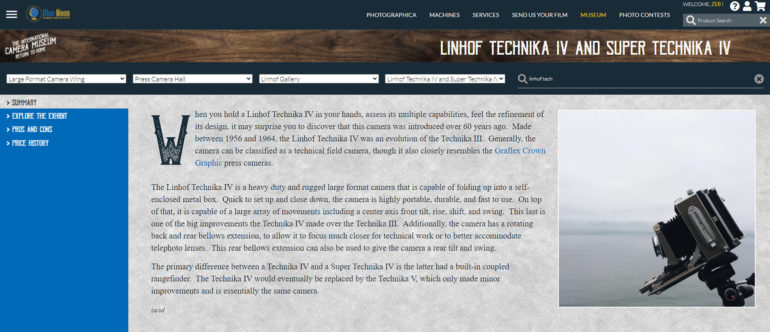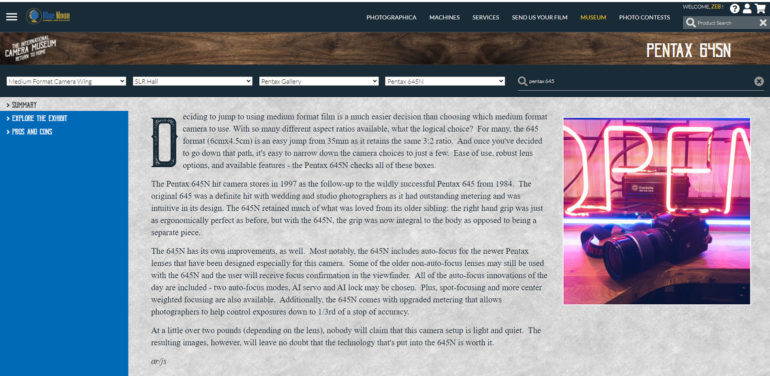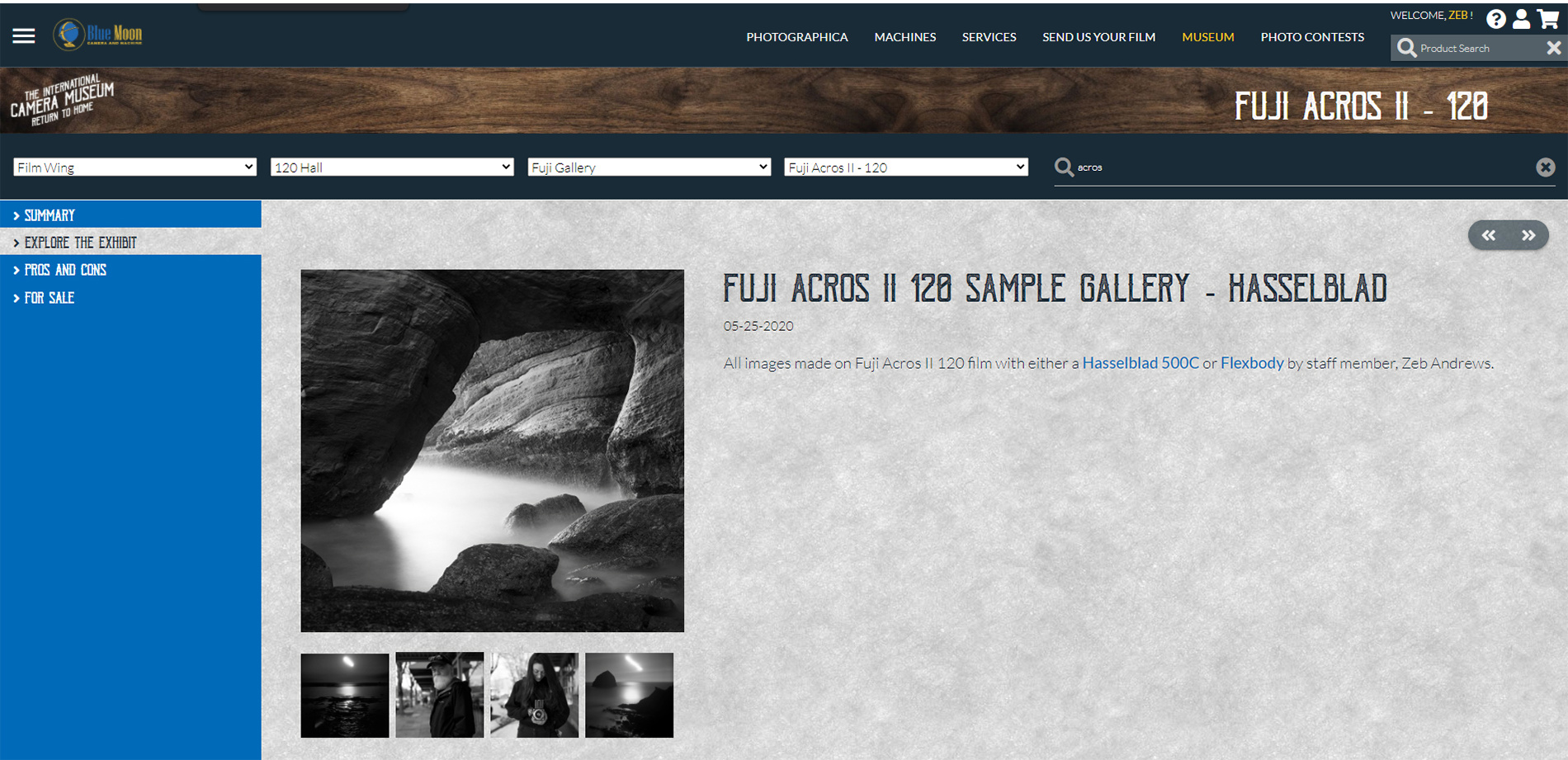Last Updated on 08/31/2020 by Mark Beckenbach
If the Blue Moon Museum of Cameras were a real place, Google Maps would label it as Heaven.
I don’t know about you, but I’m still being cautious. I don’t really want to use my museum memberships during COVID-19. But it’s been cool to see how the world has adapted. It’s opened up a lot of opportunities. And camera retailer Blue Moon Camera has used this time to create the Museum of Cameras. The museum isn’t at physical location though; it’s parked on their website. Though I’d totally entertain the idea of a physical camera museum, and I’d imagine it would have a cafe, a book store, a used camera store, various exhibits about the history of photography, parties every first Friday night, various photo booths, and a killer weekly newsletter. But until Blue Moon Camera considers making a location where you can smell the film, their virtual portal is pretty awesome.
“Because we are trying to some degree reverse engineer so much content that was made without the notion of the Museum, the Museum itself is starting out a bit multi-purpose, but that may evolve over the years as content gets made with the Museum specifically in mind rather than imported from what was made specifically for Instagram or other social media,” says Zeb Andrews in an interview with us. “So we wanted to create a section of our site to give all those thousands of pieces of content a more permanent home and one that would have more benefit to the business, not that the Instagram content hasn’t had a ton of benefit. That idea became the Museum.” Indeed, this is a large undertaking. But a few folks who are bored during quarantine could totally do it.

Click into the Museum of Cameras and you’ll see that there are various halls. You can venture into the 35mm, 120, Instant, large format, and other halls. One would think since this is virtual that they should have every camera ever made, right? Well, that’s not the case. But Blue Moon is adding to their collection. And in the meantime, I think the Museum of Cameras is a nice alternative to Camerapedia and other options. What’s more, all of the images are pretty much original photography or new photos that have been shot fairly recently.
As you venture through, you may find some things to be oddly placed. But considering the entire history of photography, you’ll realize how tough it is to categorize certain cameras. For example, would you consider the Contax G series to be rangefinders even though they had autofocus? One could say that this is just what they have on display right now. It is after all a museum and not a library. But I’m probably a spoiled NYer with a literal Museum Mile and the MET. Additionally, we have Fotographiska and ICP.

My personal critiques come more from the business side of things than with the otherwise fantastic curation. It’s totally a play on SEO–and I commend Blue Moon for trying rather than floundering and failing. But the key to many successful museums these days is making their exhibits, “Instagrammable.” It pains me physically to type that. But Blue Moon should find a way to keep the growth going. Creating an Instagram page with all this stuff is like swimming in a sea of sharks though. So finding other ways to make people really want to share their content is going to be crucial.
Phoblographer: When it came to cataloging all these things, what was that like?
Zeb: If by cataloging you mean the organization on the Museum itself, it was a ton of work with a lot of trial and error. Coming up with a tier system that hits that balance between being granular enough but not overwhelmingly specific and is intuitive to as many as possible is no small task and we don’t claim to have hit it with what we have. But thankfully the way it is built on the back end we can edit and adjust as needed as we grow the Museum. A good example of this is the Rangefinder/Viewfinder Hall in the 35mm Wing. At some point we may split that out into separate halls. We may even split it out again so that autofocus cameras have their own Hall separate from manual focus cameras.
The cataloging itself was a bit of a logistical nightmare. Almost all that content was previously created as Instagram posts. Thankfully we were able to use an API to mass download all the images with captions from Instagram into our system but from their each caption needed to be edited and polished to read appropriately for the Museum as many made Instagram references that no longer made sense in the new context. Furthermore, these posts weren’t exactly labeled with the names of the cameras photographed, so we have had to comb through identifying cameras where they are not identified in the caption (a bit of a nightmare trying to figure out which model Exa or Rolleiflex you have sometimes just from a single image). In all we imported over 2000 images and have published about half of those to the current Museum, so we still have a lot of content yet to sort through, exhibits to create to house them and so on. That project alone will keep us busy enough for the next year neverminding the creation of brand new content.

Phoblographer: There’s some stuff missing in the esoteric hall. Where’s my Fisher Price camera? 🙂
Zeb: Ha! If you want to pay us a visit and bring that camera along I will gladly make a portrait of you with it and make it a part of the Museum. In truth, many of our cameras featured there have happened in just that fashion.
Phoblographer: How comprehensive do you think this will get? It’s a decent job already, but there’s a ton more to go!
Zeb: Oh yeah there is. There are more cameras not in the Museum than are in the Museum. Since it is great to have big goals I will just say that we want the Museum at some point to include every film camera ever. This realistically will probably not happen but might as well shoot for the stars.
Phoblographer: Are you going to try to tie this into sales of any sort?
Zeb: It is our hope that the Museum has a beneficial impact on sales, definitely. We are, after all, a camera store first and foremost. The way we go about selling a camera here at the store though is one that includes as much information and education for the customer as we can provide. We will take that hour at the counter to find the right camera that fits them, then explain its functions, show them how to load their first roll of film and send them out the door with something they are truly excited to have and cannot wait to spend the rest of the day using. We want the Museum to encapsulate as much of that as possible, by extension. We want it to help educate and inform, to inspire and motivate, to spark curiosity and intrigue. And when all that is done, if that camera is currently in inventory, then there is a nice, convenient link in the Museum exhibit to take the visitor right there. Actually, it works the other way around as well. If someone is browsing our online inventory looking at a camera, and that camera has a Museum exhibit, there is a link in the item listing that takes the viewer over to the Museum so they can read up on the camera, see its pros and cons, and perhaps even see sample images made with that type of camera, helping them better quantify if that is the right camera for them or not.


